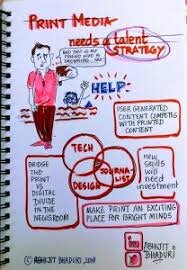Print media needs a new talent strategy
Print must look at itself as a tech business and journalists must understand technology and design
Technology is changing Work, Workers and the Workplace everywhere. Print Media is no exception. These three elements are intertwined. Each one impacts the other two. When the nature of work changes, the kind of skills needed from workers changes.Look at the methods and technology being used to create content for print media. In the analogue world, print media was the only source of truth. It was corroborated with information that came up through television and radio. News was episodic.Readers are also creating content that competes with print media. Whether it is short-form video or tweets or blogs or graphics, each time a reader becomes a subscriber, print media has a new competitor. Every content shared on WhatsApp takes away a slice of time.Every journalist competes with such content now. Digital media is all about breadth and variety. Every content is short-lived.
Print Media needs Boundaryless thinking
In a content-abundant world, print has to compete with multiple platforms from Facebook, YouTube, Snapchat, Twitter, Tik Tok, etc.Each platform has its own grammar. When the same content is repurposed for multiple platforms, it takes time and resources. There are sites that offer AI-created content by crawling the web.In advertising, the saying was that the best writers thought visually. The best visual thinkers were the ones who understood words. The digital world is boundaryless. The best journalists are the ones who understand the digital platforms. The stalwarts of print media have to be comfortable being the novice in the digital media space. It needs a change of mindset to thrive in a non-hierarchical world.
Print Media needs Technology, designers and journalists
All businesses are tech businesses. That means the business must generate real-time data on the media consumption habits of readers. Insights come from millions of data points generated every day across each platform for each individual journalist and for each story.The editors must also understand how they need to tweak every variable, from word count to the keyword used and visuals, to break the clutter. When Amazon created ebooks, they did not convert the word documents to a PDF format. They redesigned the reading experience. That is why data scientists, designers and journalists need to work together to reinvent the business model. Washington Post is a terrific example of tech, design and journalists working to create a product the reader is happy to pay for.Read: The 9 dimensions of work employees care about
New skills and attitudes needs investment in people
There was a time when all we had was a landline. Today, every individual has a mobile. So many households do not have a landline at all. The medium of print is going through the same churn. It needs to be reimagined if it has to thrive and be part of the new ecosystem. They have to rethink their way of working. Print media has to invest in upskilling and reskilling the talent. Editing in the print format has the luxury of time. Digital is often done in a shorter, breathless manner. Being able to adapt to the demands of the media needs new skills and a new attitude towards learning.Read: How Genpact reskilled 90,000 employees across 300 skills
Bridge digital-print divide
Print media has to become part of the digital ecosystem. Today, in several news organisations, there is a sharp divide between the print media and digital. Creating small squads of journalists drawn from both print and digital to work together will be the best way to expand the talent base. When a war correspondent writes about the war, the most compelling stories come from people who are there on the ground. Being able to leverage that ability to observe, empathise and articulate has been the hallmark of print. Bringing the same skills to a broader ecosystem is the investment media houses need to make.
The talent ecosystem in print media
Every consumer brand has a story to tell. So does every talent brand. Learning to tell multiple stories from multiple perspectives can be a powerful way to get the user to connect with the talent base in print. Market research used to be like that. The consumer used to be brought into a room and market researchers used to observe them through a one-way glass and draw conclusions. Today, the best market researchers step into the shoes of the people they wish to understand. Print Media could follow this model.Read: More than 25 ideas you can use to build a culture of learning
The workplace as a talent brand
Talent has a way of sniffing out which jobs and sectors are attracting the best minds. Philosophers were the highest paid profession in the Ancient Greek civilisation. That attracted the largest talent pool.As a talent scout, when I went to various educational institutions, I got a great view of which sector attracted the best people. That changed every year. If Consulting got the prime slot in one year, the next year it could be Banking or Retail walked away with the brightest people. People with the same qualification chose different sectors every year depending on a number of factors. Print Media has to discover that element which will encourage them to compete head to head with everyone else for talent. They must, in turn, take a unified view of talent. When it comes to hiring engineers or designers or journalists, the print media has to compete with other employers. The fine balance between work, workers and workplaces is a great place to start.=======Written for Business Line newspaper dated 5 Dec 2019 <You can read my previous columns on how tech is changing the future of work)



